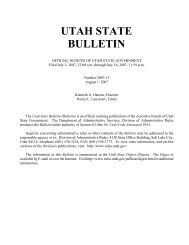Vol. 2010, No. 11 (06/01/2010) PDF - Administrative Rules - Utah.gov
Vol. 2010, No. 11 (06/01/2010) PDF - Administrative Rules - Utah.gov
Vol. 2010, No. 11 (06/01/2010) PDF - Administrative Rules - Utah.gov
You also want an ePaper? Increase the reach of your titles
YUMPU automatically turns print PDFs into web optimized ePapers that Google loves.
NOTICES OF PROPOSED RULES DAR File <strong>No</strong>. 33635<br />
ROOM 3150 STATE OFFICE BLDG<br />
450 N STATE ST<br />
SALT LAKE CITY, UT 84<strong>11</strong>4-12<strong>01</strong><br />
or at the Division of <strong>Administrative</strong> <strong>Rules</strong>.<br />
DIRECT QUESTIONS REGARDING THIS RULE TO:<br />
♦ Alan Bachman by phone at 8<strong>01</strong>-538-3105, by FAX at<br />
8<strong>01</strong>-538-3313, or by Internet E-mail at abachman@utah.<strong>gov</strong><br />
♦ Kent Beers by phone at 8<strong>01</strong>-538-3143, by FAX at<br />
8<strong>01</strong>-538-3882, or by Internet E-mail at kbeers@utah.<strong>gov</strong><br />
♦ La Priel Dye by phone at 8<strong>01</strong>-538-3240, by FAX at<br />
8<strong>01</strong>-538-3313, or by Internet E-mail at ldye@utah.<strong>gov</strong><br />
♦ Nancy Orton by phone at 8<strong>01</strong>-538-3148, by FAX at<br />
8<strong>01</strong>-538-3882, or by Internet E-mail at nancyo@utah.<strong>gov</strong><br />
INTERESTED PERSONS MAY PRESENT THEIR VIEWS ON<br />
THIS RULE BY SUBMITTING WRITTEN COMMENTS NO<br />
LATER THAN AT 5:00 PM ON 07/<strong>01</strong>/<strong>2<strong>01</strong>0</strong><br />
THIS RULE MAY BECOME EFFECTIVE ON: 07/08/<strong>2<strong>01</strong>0</strong><br />
AUTHORIZED BY: Kent Beers, Director<br />
R33. <strong>Administrative</strong> Services, Purchasing and General<br />
Services.<br />
R33-5. Construction and Architect-Engineer Selection.<br />
R33-5-1<strong>01</strong>. Purpose and Authority.<br />
As required by Sections 63G-6-5<strong>01</strong>, 63G-6-504(2),<br />
63G-6-5<strong>06</strong> and 63G-6-6<strong>01</strong>, this rule contains provisions applicable<br />
to:<br />
(1) selecting the appropriate method of management for<br />
construction contracts, that is, the contracting method and<br />
configuration that will most likely result in timely, economical, and<br />
otherwise successful completion of the construction project.<br />
(2) establishing appropriate bid, performance, and<br />
payment bond requirements including criteria allowing for waiver<br />
of these requirements.<br />
(3) <strong>gov</strong>erning appropriate contract provisions.<br />
R33-5-102. Application.<br />
The provisions of this chapter shall apply to all<br />
procurements of construction which are estimated to be greater than<br />
$50,000. Procurement of construction expected to be less than<br />
$50,000 shall be made in accordance with Section R33-3-3 (Small<br />
Purchases) except bid, performance and payment bonds shall be<br />
required unless waived in accordance with Section R33-5-355<br />
(Waiver of Bonding Requirements on Small Projects).<br />
R33-5-2<strong>01</strong>. Methods of Construction Contract Management.<br />
(1) Application. This section contains provisions<br />
applicable to the selection of the appropriate type of construction<br />
contract management.<br />
(2) Flexibility. It is intended that the Procurement Officer<br />
have sufficient flexibility in formulating the construction contract<br />
management method for a particular project to fulfill the needs of<br />
the procuring agencies. In each instance, consideration<br />
commensurate with the project's size and importance should be<br />
given to all the appropriate and effective means of obtaining both<br />
the design and construction of the project. The methods for<br />
achieving the purposes set forth in this rule are not to be construed<br />
as an exclusive list.<br />
(3) Selecting the Method of Construction Contracting. In<br />
selecting the construction contracting method, the Procurement<br />
Officer should consider the results achieved on similar projects in<br />
the past and the methods used. Consideration should be given to all<br />
appropriate and effective methods and their comparative advantages<br />
and disadvantages and how they might be adapted or combined to<br />
fulfill the needs of the procuring agencies.<br />
(4) Criteria for Selecting Construction Contracting<br />
Methods. Before choosing the construction contracting method to<br />
use, a careful assessment must be made by the Procurement Officer<br />
of requirements the project must satisfy and those other<br />
characteristics that would be desirable. Some of the factors to<br />
consider are:<br />
(a) when the project must be ready to be occupied;<br />
(b) the type of project, for example, housing, offices,<br />
labs, heavy or specialized construction;<br />
(c) the extent to which the requirements of the procuring<br />
agencies and the ways in which they are to be met are known;<br />
(d) the location of the project;<br />
(e) the size, scope, complexity, and economics of the<br />
project;<br />
(f) the amount and type of financing available for the<br />
project, including whether the budget is fixed or what the source of<br />
funding is, for example, general or special appropriation, federal<br />
assistance moneys, general obligation bonds or revenue bonds,<br />
lapsing/nonlapsing status and legislative intent language;<br />
(g) the availability, qualification, and experience of State<br />
personnel to be assigned to the project and how much time the State<br />
personnel can devote to the project;<br />
(h) the availability, experience and qualifications of<br />
outside consultants and contractors to complete the project under<br />
the various methods being considered.<br />
(5) General Descriptions.<br />
(a) Use of Descriptions. The following descriptions are<br />
provided for the more common contracting methods. The methods<br />
described are not all mutually exclusive and may be combined on a<br />
project. These descriptions are not intended to be fixed in respect to<br />
all construction projects of the State. In each project, these<br />
descriptions may be adapted to fit the circumstances of that project.<br />
However, the Procurement Officer should endeavor to ensure that<br />
these terms are described adequately in the appropriate contracts,<br />
are not used in a misleading manner, and are understood by all<br />
relevant parties.<br />
(b) Single Prime Contractor. The single prime contractor<br />
method is typified by one business, acting as a general contractor,<br />
contracting with the state to timely complete an entire construction<br />
project in accordance with drawings and specifications provided by<br />
the state. Generally the drawings and specifications are prepared by<br />
an architectural or engineering firm under contract with the state.<br />
Further, while the general contractor may take responsibility for<br />
successful completion of the project, much of the work may be<br />
performed by specialty contractors with whom the prime contractor<br />
has entered into subcontracts.<br />
(c) Multiple Prime Contractors. Under the multiple<br />
prime contractor method, the State or the State's agent contracts<br />
directly with a number of specialty contractors to complete portions<br />
36 UTAH STATE BULLETIN, June <strong>01</strong>, <strong>2<strong>01</strong>0</strong>, <strong>Vol</strong>. <strong>2<strong>01</strong>0</strong>, <strong>No</strong>. <strong>11</strong>


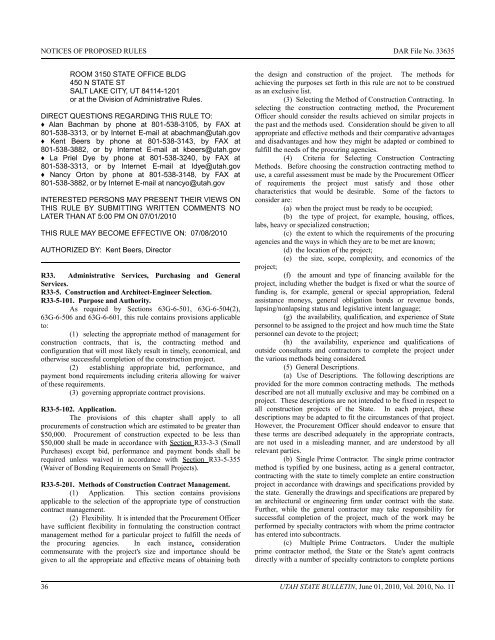


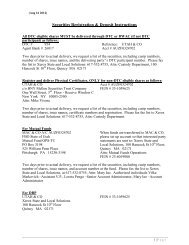

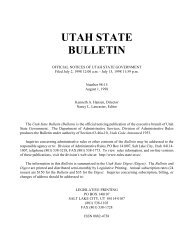
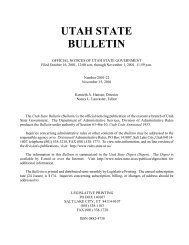



![Lynx avoidance [PDF] - Wisconsin Department of Natural Resources](https://img.yumpu.com/41279089/1/159x260/lynx-avoidance-pdf-wisconsin-department-of-natural-resources.jpg?quality=85)



